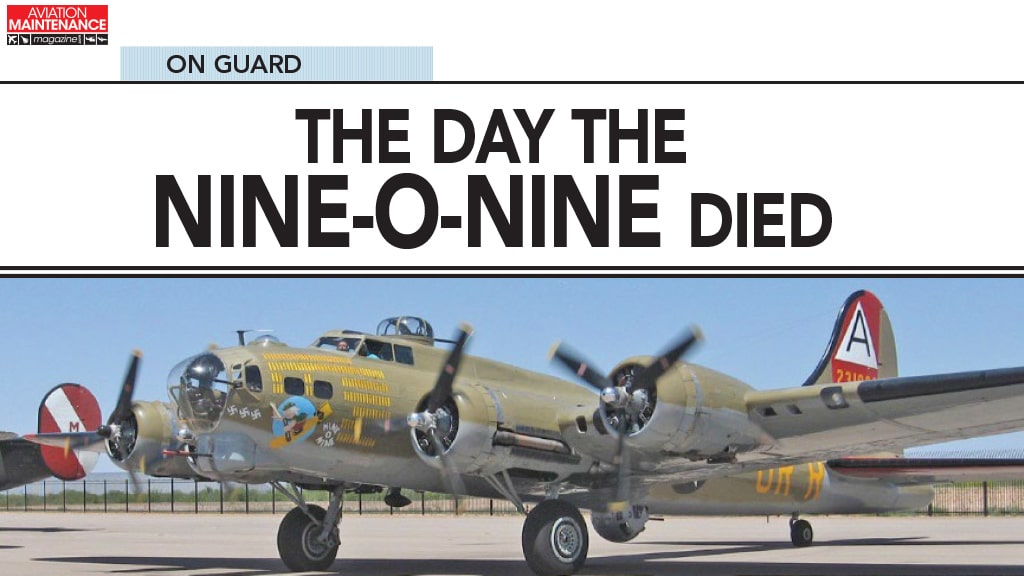Former NTSB and FAA investigator Jeff Guzzetti explains how inadequate maintenance contributed to the destruction of a rare vintage airplane and why this accident was “personal.”
As a member of the “Greatest Generation,” my father served his country in the U.S. Army Air Corps during the latter half of World War II. Dad was a navigator in the Boeing B-17 bomber (see Photo 1, next page). Of the 12,731 B-17s that were produced, over a third of them — 4,735 — were lost during combat missions. Lucky for me, he survived the war, moved back to his hometown of Beaver, Pennsylvania, became an optometrist, met my mom and raised three boys. I was his youngest and I was enthralled with his aviation adventures. The B-17 became my favorite airplane.
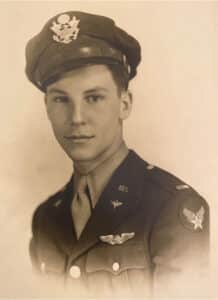
Lt. Albert J. Guzzetti; Army Air Corp, 1943. Navigator.
With a cruise speed of 182 mph, a range of 2,000 miles, and a service ceiling of 35,000 feet, the B-17 could fly faster, farther and higher than any comparable aircraft of its day. Aptly named the “Flying Fortress,” the B-17’s resilient design gained a reputation for taking a beating and still bringing its crew home alive. However, the advent of the jet age made the Fortress obsolete. After the war, most B-17s were cut up for scrap, used for research or target drones, or sold on the surplus market. As of October 1, 2019, there were only ten B-17s left in the U.S. that were airworthy. One of them was the “Nine-O-Nine” (see Photo 2 previous page).
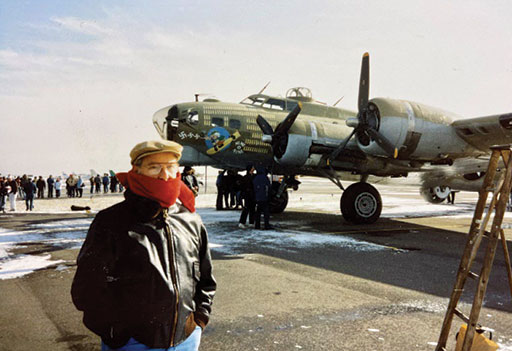
The Nine-O-Nine first came to my attention more than three decades ago, Soon after graduating as an aeronautical engineer in 1987, I was watching the evening news which aired video of a B-17 — the Nine-O-Nine — at an airshow landing at the Beaver County Airport near my hometown. The bomber veered off the runway and down into a ravine while fighting a stiff crosswind. My heart sank. Fortunately, none of the 12 people on board were killed, and there was no fire. The good people of Beaver County volunteered to drag the airplane out of the ravine and rebuild it at the airport.
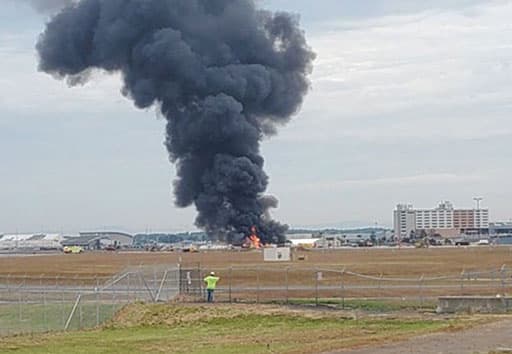
It took a few years, but the repair was finally completed in February 1991. The public was invited to the airport to watch the Nine-O-Nine start up its engines. I was an air safety investigator for Cessna in Wichita, Kansas, at that time, but I flew back to Pennsylvania to share the event with Dad. I was so proud of him, my hometown and the resurrection of the greatest airplane of all time. I captured the event with my Kodak camera (see Photo 3 above). I treasure that photo, especially since my father died two years later from Lou Gehrig’s disease.
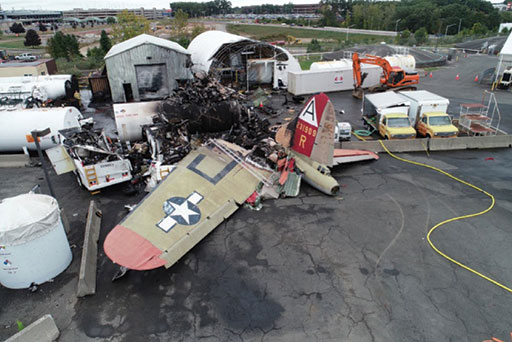
Fast forward 27 years, to October 2, 2019. I had recently retired from the FAA and was surfing the web when I read the news that the Nine-O-Nine had crashed again. This time, the accident occurred at Bradley International Airport near Hartford, Connecticut. While landing on runway 6, the Nine-O-Nine struck approach lights, veered off the right side of the runway, and collided with a deicing fluid tank. Both pilots and five passengers were killed. The crew chief and four other passengers sustained serious injuries. The airplane was destroyed by impact forces and a postcrash fire (Photos 4, previous page and 5 at left).
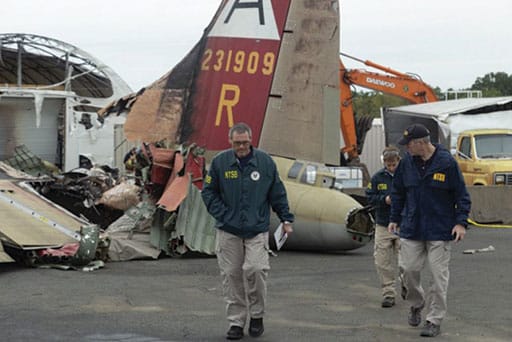
My heart sank again. There would be no rebuilding of the famed B-17 this time. How could have this happened to such a special and revered airplane?
The Investigation
The NTSB launched a go-team to Hartford to investigate the accident, led by Bob Gretz, one of the best investigators I know (see Photo 6, lower left). The team was briefed that the vintage bomber was being operated by the non-profit Collings Foundation as a Part 91 “Living History Flight Experience” (LHFE) sightseeing flight to allow the public to experience the significance and history of the bomber.
The captain was 75-year-old Ernest “Mac” McCauley. He held a commercial pilot certificate and a type rating for the B-17. He also held a valid FAA medical certificate and reported 14,500 hours of flight time, of which nearly half was logged in the Flying Fortress. He was the most experienced living B-17 pilot in the world. In addition, he held a mechanic certificate with airframe and powerplant ratings.
McCauley resided in Arizona, but was a full-time volunteer pilot and traveled with the B-17 wherever it went. He was also the director of maintenance for the Collings Foundation. As the recovered aircraft logbooks revealed, he would sign off the daily checks and any routine or non-routine maintenance that occurred during the course of flying. In an interview with the NTSB, the surviving crew chief explained that the Nine-O-Nine was the center of McCauley’s life. “I mean, he lived in that thing; cleaned it, worked on it, flew it,” he explained.
During the accident flight, the Nine-O-Nine had flown about eight miles after takeoff and reached an altitude of 800 feet when McCauley reported a problem and requested an immediate landing. After the air traffic controller asked why, McCauley replied that the airplane had a “rough mag[neto]” on the No. 4 engine. The veteran pilot shut down the no. 4 engine and feathered the propeller.
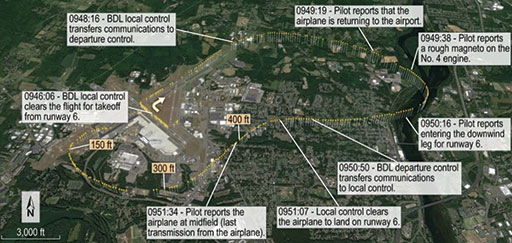
In order to balance the loss of thrust on the outboard engine of the right wing, McCauley accelerated the No. 3 inboard engine to compensate — but he was likely unaware that the no. 3 engine was also in trouble. More about that later.
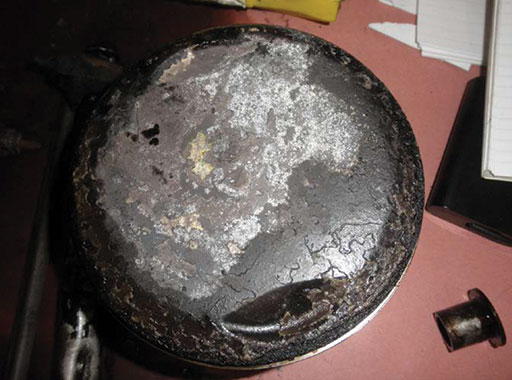
When the airplane was about 400 feet above the ground, it was on a midfield right downwind leg for runway 6. Witness video showed that the landing gear had already been extended by that time, even though the airplane still had over two miles to fly in the traffic pattern before reaching the runway. Unfortunately, a much closer runway had been NOTAMed closed; the holes in the Swiss cheese were lining up to conspire against the Nine-O-Nine.

Recorded ADS-B data (see Photo 7, upper right) revealed that during the return to the airport, McCauley flew the pattern at an airspeed of 100 mph far, far below the 120 mph required to minimize the loss of altitude. The NTSB determined that the airplane was unable to maintain altitude at the lower airspeeds because the pilot could apply only a limited amount of power to the left-wing engines while simultaneously trimming the asymmetric thrust with the available rudder authority. If McCauley had lowered the airplane’s nose to maintain airspeed, and kept the landing gear retracted until landing on the runway was assured, the NTSB’s calculations showed that the Nine-O-Nine would have overflown the approach lights and touched down beyond the runway threshold.
Inadequate Maintenance
In addition to the McCauley’s improper actions piloting the Nine-O-Nine, his lack of action with maintenance before the flight was also examined. As the Collings Foundation’s director of maintenance, he was responsible for performing the Nine-O-Nine’s maintenance while it was on tour.
Vintage aircraft require a significant amount of care and feeding. Structure and components are decades old. In fact, for each hour a B-17 spends in the air, ten hours are spent on the ground in maintenance. An engine overhaul can cost $40,000, and required wing-spar inspections and repairs can cost $100,000.
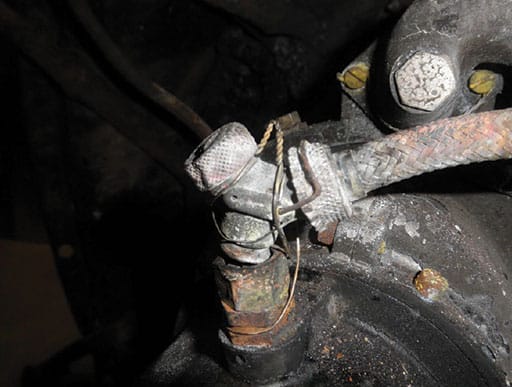
The Nine-O-Nine was equipped with four Wright R-1820-97 Cyclone radial engines, each of which had nine massive cylinders, or “jugs” as the mechanics of the day would call them. The continuous airworthiness program for the B-17G consists of four inspections conducted at a 25-hour interval. Inspections one through four are performed sequentially each 25 flight hours and then repeated.
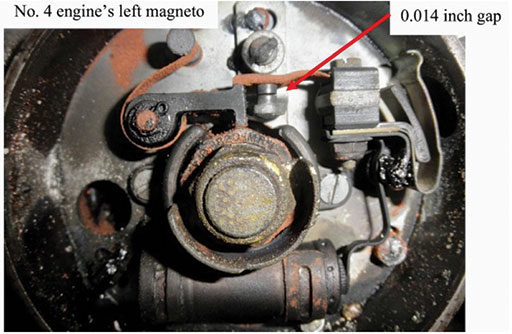
Examination by investigators of the Nos. 3 and 4 engines – both located on the right wing of the airplane – revealed maintenance issues that were not adequately addressed by McCauley or his team.
For example, the No. 3 engine’s 25-hour inspection — which occurred less than one month before the accident — required that the spark plugs be cleaned, inspected, tested, or replaced with new plugs, and the gap between the electrodes should have been checked. However, the spark plugs were worn with gaps between the electrodes that were beyond the manufacturer’s specifications. The electrodes were too close together, which caused them to spark excessively. Most of the nine piston heads displayed white coloration that were consistent with detonation rather than normal combustion, with the no. 4 cylinder exhibiting the evidence of significant detonation (see Photo 8, previous page). Detonation in a piston engine occurs when the fuel-air mixture in the cylinder explodes prematurely instead of being ignited by spark plugs and burning evenly and smoothly, as occurs with normal combustion. Detonation can damage pistons and cause a loss of power.
The No. 4 engine (see Photo 9, previous page) had its 25-hour inspection nine days before the accident, but the NTSB’s teardown of that engine found a different problem. The engine’s left magneto P-lead — the electrical connection between a magneto and the cockpit ignition switches – was partially pulled out of the magneto housing, and the grounding tab was in contact with the housing. A single strand of safety wire was observed around the retaining nut (see Photo 10 page 52). A functional test of the magneto showed that the contact between the grounding tab and the housing resulted in the magneto being shorted to ground and unable to function. The right magneto’s P-lead was also partially engaged in its fitting, and the grounding tab did not contact the magneto housing. Perhaps this damage was due to impact, but not likely, said the NTSB. Additionally, the right magneto’s gap between the points was 0.004 inch, which was less than the minimum gap (0.008 to 0.010 inch) that the manufacturer required (see Photo 11 page 52). When the magneto was tested, the ignition leads for the no. 8 cylinder did not spark; the ignition leads for the other eight cylinders did produce sparks, but they were weak and intermittent. These discrepancies likely added to the loss of power on the No. 4 engine.
Probable Cause and Lessons Learned
The NTSB determined that the probable cause of the accident was the pilot’s failure to properly manage the airplane’s configuration and airspeed after he shut down the No. 4 engine following its partial loss of power during the initial climb. However, the Board also stated that “the pilot/maintenance director’s inadequate maintenance” contributed to the accident by causing the partial loss of engine power to the Nos. 3 and 4 engines.
As a result of this investigation, and others involving similar aircraft and operations, the NTSB issued a formal safety recommendation to the FAA to “develop national safety standards, or equivalent regulations, for revenue passenger-carrying operations that are currently conducted under Part 91, including … flights conducted in …living history flight experience and other vintage aircraft flights.” The NTSB stated that standards or regulations should include “operationally specific maintenance” requirements.
For its part, the FAA issued Notice N 8900.568 to provide FSDO inspectors with increased oversight procedures for LHFE operators. The notice indicated that the B-17 accident “revealed the need to bolster surveillance and oversight of LHFE exemption holders.” The notice also instructed inspectors to perform an audit of all LHFE operators within their geographic jurisdiction.
The day the Nine-O-Nine died three years ago brought back shades of the sadness I felt the day my father died 30 years ago. Dad remains enshrined in my memory, as does the legendary airplane type that he once guided during a critical time in our nation. With only nine airworthy B-17s left, and the steady decrease of the population of WWII vintage airplanes of all types, the operators of these magnificent machines must ensure that meticulous maintenance is performed on them to preserve our nation’s history.
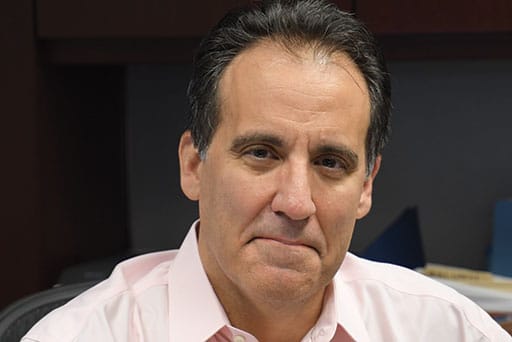
Jeff Guzzetti is the president of Guzzetti Aviation Risk Discovery (GuARD), an aviation safety consulting firm following a 35-year career with the National Transportation Safety Board, Federal Aviation Administration (FAA), and other agencies. During his 18 years at NTSB, Guzzetti was a field investigator, “go-team” engineer and Deputy Director. He then served as an Assistant Inspector General at the Dept. of Transportation and testified before Congress regarding aviation safety audits. In 2014, Guzzetti served as the Director of FAA’s Accident Investigation Division in Washington, D. C. until his retirement in 2019. Guzzetti graduated from Embry-Riddle University with a degree in Aeronautical Engineering, and he is a commercial-rated pilot with multi-engine instrument ratings in airplanes, seaplanes and gliders.
